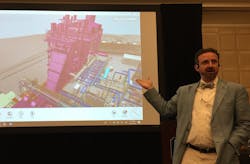Virtual Plant Provides Easy Access to Asset Information
It’s not uncommon to hear about the need to break down the silos that exist in an enterprise, but finding a company that has been successful in achieving this goal is much less common. Southern Company is using AVEVA’s suite of design, simulation and engineering programs to do just that—bridging a divide between the engineering and design side of the business and the operations and maintenance side. With this toolset, the energy utility has been able to significantly reduce the time it takes to access asset information and leverage it in a virtual plant environment to support activities related to both operations and maintenance as well.
Southern Company owns the largest coal-fired power plant in North America. When the innovation manager at Plant Scherer in Juliette, Ga., got a look at the design, simulation and engineering suite Southern’s Engineering and Construction Services (E&CS) department had been working with, she wanted to know where the applications were for operations and maintenance. It wasn’t long before the project’s resources got diverted to figuring out its use on a hydrogen purge for Plant Scherer.
Hydrogen purge is a very controversial topic for Southern, according to Tedd Weitzman, project manager for E&CS’s Performance Improvement Team. “It’s a pretty lengthy, complicated process,” he noted. “They don’t do it too frequently. But when they do, they have to follow the procedures by the letter or else things will go squirrelly.”
Here was an area where the integrated design program suite had the potential to shine. Weitzman demonstrated the full object model to attendees at the AVEVA World Conference North America this week in Dallas, showing how easily he could zoom in to a digital representation of an entire plant, walk through highly detailed assets, clicking on specific pieces of equipment to pull up a range of information related to it. “It takes three minutes or less to find the information you need to do your job,” he said.
Having a fully navigable model doesn’t necessarily mean it’s easy to find the information you need. But Weitzman also showed the ability to group assets any way you want. “You still see the context of the facility, but it’s all grayed out. When you select a query, it highlights everything that’s part of that query,” he demonstrated, showing various parts of an asset pop up in a purple color. “It very easily lets me visualize just the boiler feed part of plant.”
Weitzman’s team used those capabilities to create a proof of concept for the hydrogen purge. “We went out and scanned a small footprint of the facility. It was just a limited number of scans—just a day’s worth—and we did a little bit of modeling,” Weitzman said, explaining that the idea was just to show what could be done with the scans.
He then scrolled quickly through a typical hydrogen purge manual to show the massive number of instructions involved. Instructions run through things like making sure valve G-131 is open, then close G-132 and do this, then close G-131, etc. Somebody new to the procedure might be able to guess that G-132 is next to G-131, but do they really want to guess about that for a hydrogen purge? Instead, they can click on the G-132 label in the model and be shown exactly where the valve is. “Does anybody not see the value in that type of functionality?” Weitzman asked.
The team took just one page from the procedures and automated it to show the capabilities. “We were able to do this in a very short period of time, at a very low cost,” Weitzman said. “That is key with all of this—very low cost.”
Southern completed a second proof of concept on a boiler feed pump turbine in just two weeks, modeling the skid to show the ability to link information from other systems directly into the environment and view inventory on the fly.
“We see the vision, we see the value in our AVEVA solution,” Weitzman said. “What they’re doing now is digitally enabling all four units of Plant Scherer. There will be somewhere around 1,800 assets that will be modeled.”
Plant Scherer’s innovation manager, Stacy Egnor, who was sitting in the audience, commented on the usefulness of the tools and where she would like to see it go for maintenance capabilities. “I want something to tell me that I have six or eight months of life left on this widget,” she said. “I don’t want a call in the middle of the night saying that the boiler is about to blow.
Having ready digital access to assets will be an important step going forward as well, Egnor said. “In the past, you’ve left us drawings. Moving forward, you’ll leave us scans,” she said.
Beyond the technology itself, the change management is also important, Weitzman noted. He stressed the importance of being able to accept some failure. “As far as I know, we are the first to go full-in with the AVEVA design suite. We did everything, and we did it all at once. And it was very successful,” he said. But he also stressed, “You can deploy a really great technology against bad processes and just screw up that much faster. We try not to do that.”

